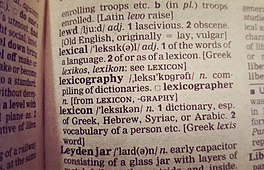Documentation:RelLex/Sḵwx̱wú7mesh Sníchim-Xwelíten Sníchim Sḵexwts/Squamish-English Dictionary
Sḵwx̱wú7mesh Sníchim-Xwelíten Sníchim Sḵexwts/Squamish-English Dictionary
| Relational Lexicography Knowledgebase | |
|---|---|

| |
| About RelLex | |
| An index of under-resourced North American language references, including print and digital dictionaries. | |
| Browse by | |
| About the Knowledgebase | |
| Find our filterable Knowledgebase of dictionaries and lexicography technology at https://knowledgebase.arts.ubc.ca/. | |
Language Name
Squamish.
Alternate Language Names
Sḵwx̱wú7mesh sníchim, Sḵwx̱wú7mesh, Sḵwx̱wúm'ish.
Region
British Columbia, Canada.
Who
Squamish Nation Dictionary Project.
Others Involved
Nekwsáliya Margaret Locke, Kwináḵatamat Lucille Nicholson, Ts'elts'elmát Addie Kermeen, Skwetsátenat Valerie Moody, X̱ats'alánexw Tanáynexw Alex Williams, Tiyáltalut Audrey Rivers, Chiyálhiya Lila Johnston, Neḵwníḵwelut Barbara Charlie, Xwelap'últ Stella Newman, Skwetsátenat-t Doris Williams, P'eḵálten-t Ernie Harry, X̱áleḵ'-t Lawrence Baker, Telsentsút-t Frank Miranda, Nora Desmond, Sx̱ananált-t Yvonne Joseph, Skwétsiya-t Eva Lewis, Frank Guerrero, Kwelíx̱welut-t Tina Cole, Kwítelut-t Lena Jacobs (Elders); Vanessa Campbell, T'nax̱wtn Peter Jacobs (Editors); Ḵ'etx̱ímtn Alroy Baker, Sekyú Siy̓áṁ Chief Ian Campbell, Tseytsáyax̱mat-amáts Rebecca Campbell, Xwáchtenat Kathy LaRock (Contributing Researchers); Elizabeth Currie, Dr. Carrie Gillon, Linda Watt, Dr. Leora Bar-el (University Support); Snítelwet Deborah Jacobs, Siyámiya Damara Jacobs-Morris, Kirsten Baker-Williams, Chrystal Nahanee (Administrative Support).
Publishing Information
Published 2011 by the Squamish Nation Education Department, North Vancouver, in association with the University of Washington Press, Seattle.
How People are Cited
People are cited by name in the Sḵwx̱wú7meshulh Sḵexwts Sḵéxwḵexw—The Squamish Dictionary Project Personnel on p. v and vi.
How Information is Cited
Speakers who worked on this dictionary directly are cited in Sḵwx̱wú7meshulh Sḵexwts Sḵéxwḵexw—The Squamish Dictionary Project Personnel. Speakers who have impacted this dictionary through earlier work with the Squamish language are cited in Chet txwtéta7 tkwétsiw̓it nilh ta sts'its'áp'swit: Background (pp. xi–xiii), where previous language work and publications are also cited.
Where is Information Coming from
Information in this dictionary comes from speakers, including those who have worked with anthropologists over the last two hundred years (detailed in the paragraph below), students and teachers of the Sḵwx̱wú7mesh sníchim lessons beginning in the 1960s and continuing since, elders who have been part of the Ta Nexwníw̓n ta a Ímats (Teachings for Your Grandchildren) group since its start in 1993 and continuing since, and the staff of the Sḵwx̱wú7mesh sníchim program.
This dictionary also uses the previous works from anthropologists and linguists dating back to the 1800s, starting with the first written compilation of Squamish by anthropologist Franz Boas. It is not known which speakers from language community Boas worked with. Later in the century, anthropologist Charles Hill-Tout collected Squamish words, sentences, and legends, working with Melkw's, Annie Carasco, Annie Rivers, and Chief Thomas (Sḵwx̱wú7mesh). In the mid 1930s, anthropologist Homer Barnett worked with Jimmy Frank (Sḵwx̱wú7mesh). A critical resource for this dictionary was linguist Aert H. Kuipers' The Squamish Language: Grammar, Texts, Dictionary, with the first volume published in 1967 and the second in 1969. Kuipers worked with Isaac and Lizzie Jacob, Alec and Mary Peters, and Chief Louis Miranda (Sḵwx̱wú7mesh). In the 1960s and 70s, anthropologists Randy Bouchard and Dorothy Kennedy founded the BC Native Language Project and, as such, began documenting Squamish language and culture with the help of many Sḵwx̱wú7mesh elders at the time, including Louis Miranda.
Tools and Framework used
This dictionary is available as a physical book.
Access
This dictionary is accessible through libraries.
Included Languages and Directionality
Squamish to English; English to Squamish.
Dialects Included
No dialect is specified for this dictionary.
Type of Dictionary
This is a bilingual, bidirectional dictionary introduced by a brief grammar.
How are Entries Organised
Entries are organized alphabetically by Squamish in the Squamish–English section of Ta Sḵexwts (The Dictionary) according to the alphabet on p. xvii. Entries include the Squamish headword, variations of its spelling/pronunciation in Squamish, a phonetic pronunciation, an English translation, and the part of speech. Some entries also contain information about where the word came from if it was borrowed from another language.
Entries are organized alphabetically by English in the English–Squamish section of Ta Sḵexwts (The Dictionary). This section is a word list, so entries only include the English headword and the Squamish translation(s). No other information is included in the entries.
The grammar that precedes the dictionary, starting on p. 3, begins with a guide to pronouncing the Squamish alphabet. The rest of the grammar offers a brief overview of the Squamish language and how Squamish sentences are formed. Information discussed includes the subject of Squamish sentences, the role of pronouns, past and future tense, asking questions, object endings, possessives, endings with specific meanings, relative clauses, and determiners and demonstratives. The grammar includes several helpful charts throughout to summarize information covered.
Other Features
| Feature | Included | More Information |
|---|---|---|
| Guide to use and understand | ✅ | In Nilh welh axw xwekws ti sḵexwts—How to Use This Dictionary on pp. xvi–xix |
| Audio | ❌ | |
| Images | ❌ | |
| Example phrases | ❌ | Not in the dictionary entries, however, there are several in the grammar section |
| Speakers marked | ❌ | |
| Dialects marked | ❌ | There is only one dialect included |
External Links
Reference on WorldCat: https://www.worldcat.org/title/580105040
A review of the dictionary from Honoré Watanabe (2011) in Anthropological Linguistics, Vol. 53, No. 2: https://muse-jhu-edu.eu1.proxy.openathens.net/article/470438